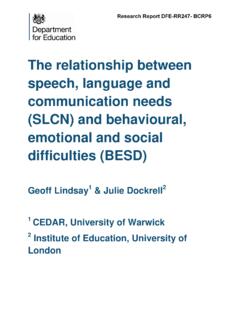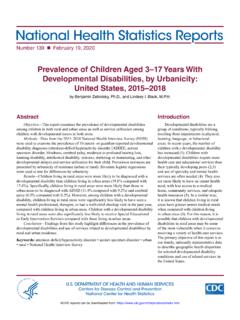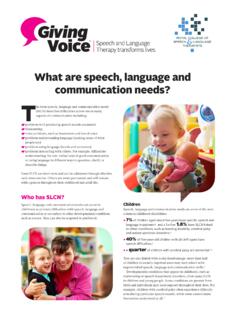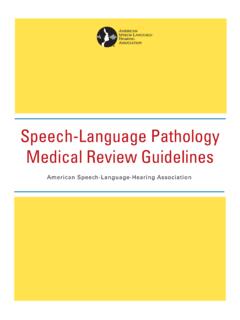Transcription of Selective Mutism: A Three-Tiered Approach to Prevention ...
1 53 Selective Mutism: A Three-Tiered Approach to Prevention and Intervention Busse and Jenna Downey,Chapman UniversitySelective mutism is a rare anxiety disorder that prevents a child from speaking at school or other community settings, and can be detrimental to a child s social development. School psy-chologists can play an important role in the Prevention and treatment of Selective mutism. As an advocate for students, school psychologists can work with teachers, parent caregivers, speech pathologists, and other support staff toward helping children who may develop or have selec-tive mutism. The purpose of this article is to present school-based Prevention and intervention approaches within a Three-Tiered Approach that may reduce the incidence and severity of selec-tive mutism.
2 We present theories and research on the etiology and prevalence of the disorder, followed by a review of intervention methods and research at each tier. Based on the theoretical and research literature base, we conclude that early intervention may result in the Prevention and amelioration of many occurrences of Selective : Selective Mutism, Childhood Anxiety Disorders, Social Phobia, Prevention , TreatmentThe purpose of this article is to present school-based Prevention and intervention approaches within a Three-Tiered Approach that may reduce the prevalence and severity of Selective mutism. Children with Selective mutism (SM) experience a consistent failure to speak in specific social situations (in which there is an expectation for speaking, , at school) despite speaking in other situations (American Psychiatric Association [APA], 2000, p.)
3 78). To be diagnosed with SM, a child s lack of speech : a) must last for at least one month, excluding the first month of school; b) must interfere with educational or occupational achievement or with social communication; c) cannot be due to any lack of knowledge or discomfort with the spoken language ; and d) cannot solely be due to a communication disorder, perva-sive developmental disorder, schizophrenia, or any other psychotic disorder (APA, 2000). Selective mutism is widely characterized as a disorder primarily linked with social anxiety (Berg-man, Piacentini, & McCracken, 2002; Chavira, Shipon-Blum, Hitchcock, Cohan, & Stein, 2007; Ford, Sladeczek, Carlson, & Kratochwill, 1998; Kratochwill, 1981; Stone, Kratochwill, Sladeczek, & Serlin, 2002).
4 SM often can be confused with other speech issues, such as the silent period some children experience when learning a second language , the absence of speech due to aphasia or deafness, or the absence of speech sometimes associated with autism (Cline & Baldwin, 2004). The primary character-istic that differentiates this disorder from related conditions is that children who experience SM usually speak freely in other environments, and their failure to speak usually occurs at school (Leonard & Dow, 1995).Not speaking in school may hinder a child s academic performance and social development in par-ticular, although more research needs to be conducted on the short and long term negative consequences of SM.
5 Not surprisingly, the short-term effects have been found to include heightened anxiety and social skills deficits ( , Bergman, et al., 2002; Cunningham, McColm, & Boyle, 2006; Ford, et al., 1998). The long-term effects of SM have been infrequently studied, with two well-controlled studies indicat-Correspondence concerning this article should be addressed to Busse, Counseling and School Psychology Program, College of Educational Studies, Chapman University, One University Drive, Orange, CA 92866. Email: School Psychology, 2011, Vol. 1554ing that the majority of cases remitted without intervention, however young adults with former selec-tive mutism described themselves as less independent and having more social problems than controls (Remschmidt, Poller, Herpetz-Dahlmann, Hennighausen, & Gutenbrunner, 2001; Steinhausen, Wachter, Laimbock, & Metzke, 2006).
6 Furthermore, many cases of SM persist if not treated (Crundwell, 2006; Ford, et al. 1998; Stone, et al., 2002), which indicates the need for intervention. Interventions with SM are especially important in elementary schools, because the majority of cases are first identified in pre-school or kindergarten (Leonard & Dow, 1995; Stone, et al, 2002). School psychologists can play an important role in implementing Prevention at the universal level, and providing more focused interven-tions for children who may be at-risk for SM. In this article, we present interventions for SM, following a Three-Tiered Approach (see Table 1). The first tier, or primary Prevention , focuses on Prevention methods that may be implemented school-wide to reduce the development of SM.
7 The second tier, or early onset interventions, involves interventions that can be implemented with groups or in the classroom for children showing signs of SM. The third tier focuses on individual treatment methods implemented both in and outside the classroom for children who have developed the 1 Three Tiered Interventions for Selective Mutism Selective Mutism Intervention 28 Table 1 Three Tiered Interventions for Selective Mutism Tiers Examples of Intervention Methods Tier I Parent/Caregiver newsletters and trainings on the identification and Prevention of potential anxiety problems School-wide oral communication strategies: Maintaining expectancies for speaking, providing opportunities to respond, wait-time for responses, minimizing reinforcement of nonverbal communication Preparation of preschoolers and families for the transition to kindergarten Tier II Early identification of children who are at-risk for or have Selective mutism Child-focused oral communication strategies.
8 Maintaining expectancies for speaking, providing opportunities to respond, wait-time for responses, minimize reinforcement of nonverbal communication Contingency management Shaping Group therapy Tier III Family and play therapy Contingency management Shaping Social skills training Stimulus fading Systematic desensitization/relaxation training Self-modeling Psychopharmacological therapy 55concePtuaLiZaton and etioLoGY oF Selective MutisMA disorder like SM was first described in the late 1800s by Adolf Kussmaul, who called the disorder aphasia voluntaria, which stemmed from the interpretation that the disorder involved a voluntary deci-sion not to speak (Cohan, Chavira, & Stein, 2006; Krysanski, 2003; Standart & Le Couteur, 2003).
9 In the early 1930s, the disorder was referred to as elective mutism which came to be called Selective mutism in the 1970s and 80s (Krysanski, 2003), the term that is used in the most current version of the DSM (APA, 2000). The change in terminology reflects an emphasis on a child s consistent failure to speak in select environments. This emphasis represents an adjustment in the criteria for SM from former defi-nitions which described the disorder as a refusal to speak. The word refusal was changed because it indicated that children with the disorder simply were being oppositional or defiant in choosing not to speak (Cline & Baldwin, 2004). Early theories on the causes of SM often focused on the family and experiences with trauma, such as a hostile home environment, physical or sexual abuse, or tragic events such as the death of a loved one (Leonard & Dow, 1995).
10 Although trauma may still be believed to be the cause for some cases of SM, there is limited evidence to support this theory. Psychodynamic theorists often conceptualize SM as a child s reaction to an unresolved conflict with parents or caregivers to gain control over some aspect of the child s life (Krysanski, 2003). Similarly, family systems theorists often view SM as a product of con-flicting familial relationships (Anstendig, 1998). Behaviorists typically view SM as a result of negatively reinforced learning patterns that teach the child to use silence as a method of reducing or controlling their anxiety in reaction to specific stimuli (Krysanski, 2003). Selective mutism is most commonly found to be co-morbid with social anxiety.


















